Ensuring GDPR compliance is essential for any team involved in software testing and software quality assurance. As GDPR regulations and data privacy laws become increasingly stringent, QA teams must adopt a structured GDPR compliance checklist to mitigate risk and safeguard personal data.
Software testers play a critical role in validating data protection mechanisms, ensuring test automation frameworks don’t expose user information, and applying security testing services to prevent leaks. From validating data minimization to enforcing data breach protection, every step matters.
Leveraging test automation tools like Selenium and adopting best practices in quality assurance testing will help teams comply with data privacy regulations while maintaining performance. This 8-point checklist equips testers with a clear path to GDPR data protection.
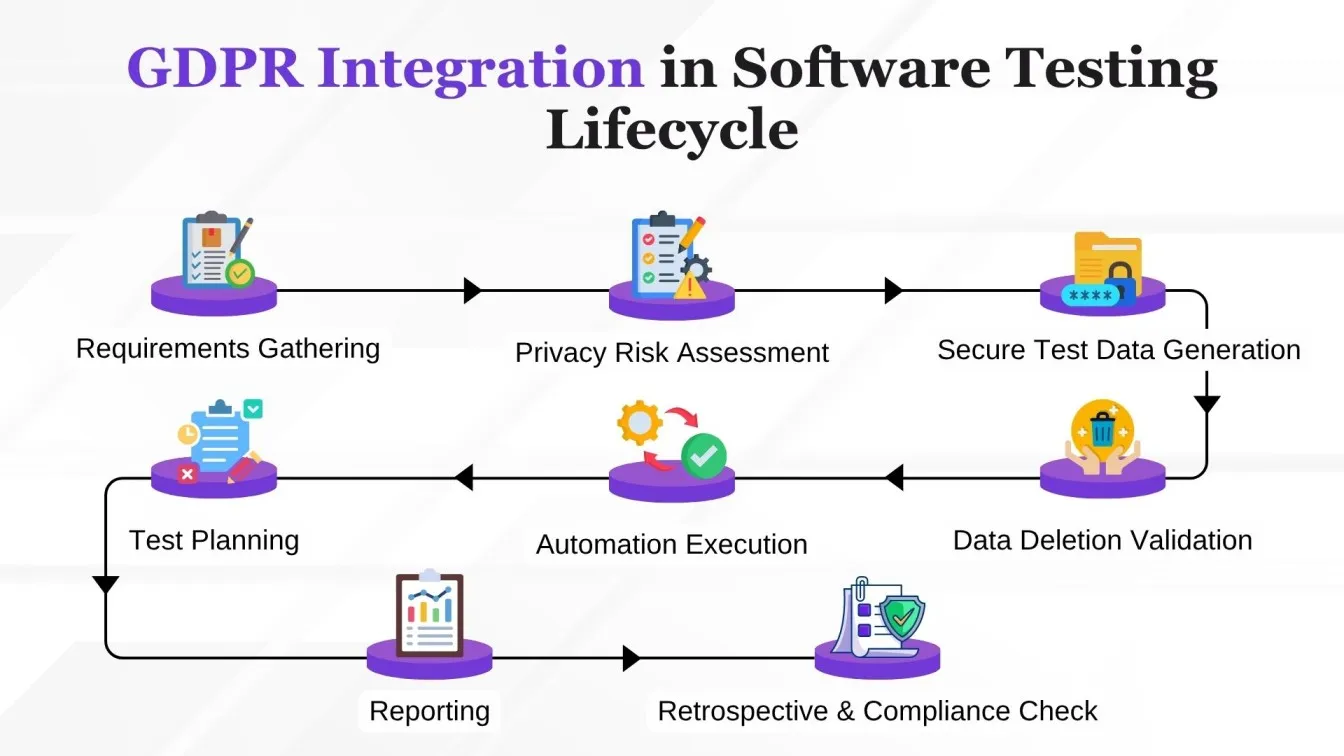
✨ GDPR Compliance & QA Testing Overview
📌 Purpose: Learn how software testers play a key role in meeting GDPR compliance requirements.
📌 Key Focus: Understand data privacy regulations, security controls, and the importance of Privacy by Design in QA.
📌 Testing Practices: Explore GDPR-focused software testing strategies like automation, encryption, and data deletion validation.
📌 Tools & Techniques: Discover top software testing tools and automation frameworks used for GDPR compliance and data protection.
📌 Takeaway: Get a clear GDPR compliance checklist for QA teams to build secure, privacy-driven software testing processes.
What Is GDPR and Why It Matters to Software Testers
The General Data Protection Regulation (GDPR) is a key data protection law introduced by the European Union to enhance data privacy and strengthen information security policies. For software testers and quality assurance professionals, GDPR compliance is essential.
It sets clear requirements around data subject rights, data flow mapping, storage limitation, and lawful processing under Article 6. QA teams must integrate principles such as Privacy by Design and risk mitigation strategies to prevent data breaches and ensure the safe handling of user information.
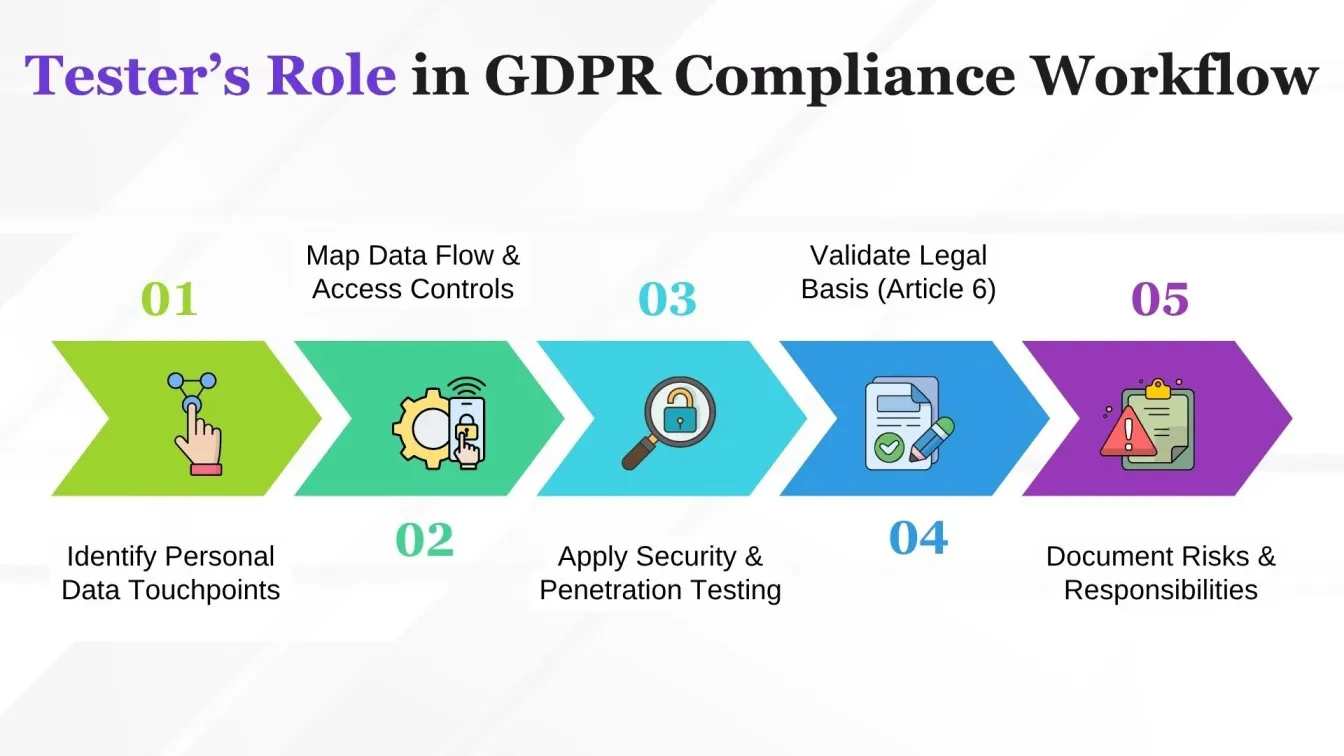
Security testing, penetration testing, and internal audits play a vital role in identifying vulnerabilities. Aligning with standards such as ISO 27701, BS 10012, and frameworks like NIST SP 800-171 Revision 2 ensures strong compliance.
GDPR also emphasizes the importance of documentation, including maintaining a risk register and understanding responsibilities outlined by the European Data Protection Board. For testers, meeting GDPR requirements safeguards data, supports accountability, and promotes trust in digital services.
Understanding the Role of QA in GDPR Compliance
In GDPR compliance, the role of Quality Assurance (QA) is crucial in enforcing data protection regulations throughout the software lifecycle. QA teams ensure that software quality assurance testing services align with data privacy regulations and support compliance with frameworks like ISO 42001 and SOC 2.
Through comprehensive internal audits, QA professionals help identify gaps in user rights, such as the Right of Access and the right to data portability. They also contribute to Data Protection Impact Assessments (DPIAs) by testing for risks in applications and monitoring compliance readiness.
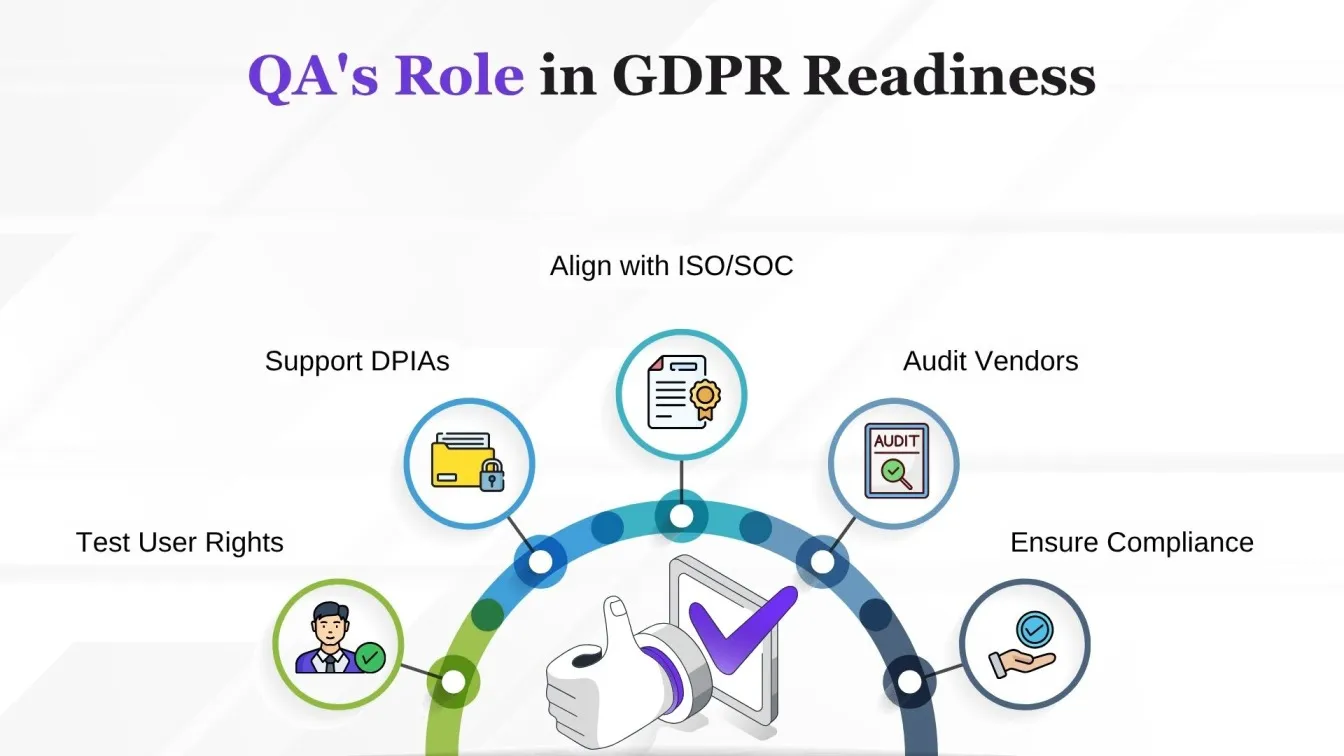
With tools like API testing tools and security testing tools, QA ensures adherence to policies guided by the European Data Protection Board. Their efforts strengthen the risk-management framework, protect intellectual property, and verify the integrity of third-party integrations across software environments.
Implementing Data Minimization in Test Environments
Implementing data minimization is a critical part of GDPR compliance in software testing. It ensures that QA teams collect, store, and process only the data necessary for testing while aligning with data privacy laws and GDPR compliance requirements.

- Use synthetic test data or data protection software instead of real user information to support data breach protection.
- Map your data flow using a data flow audit to identify and limit the exposure of personal data.
- Validate compliance with Article 30 through proper documentation of data usage in QA.
- Adopt a test automation framework that respects storage limitations and eliminates residual data post-execution.
- Ensure all software unit testing is aligned with risk mitigation strategies and data subject rights under the EU General Data Protection Regulation.
Securing Data Handling During Software Testing
Securing data handling in software testing services is crucial for maintaining GDPR compliance and implementing robust security controls. QA teams must align with ISO 27001 standards and implement layered security measures to prevent data breaches during test cycles. Establishing a clear data flow map helps monitor data transfers and identify gaps in protection. Integrating an incident response plan ensures a quick reaction to vulnerabilities.
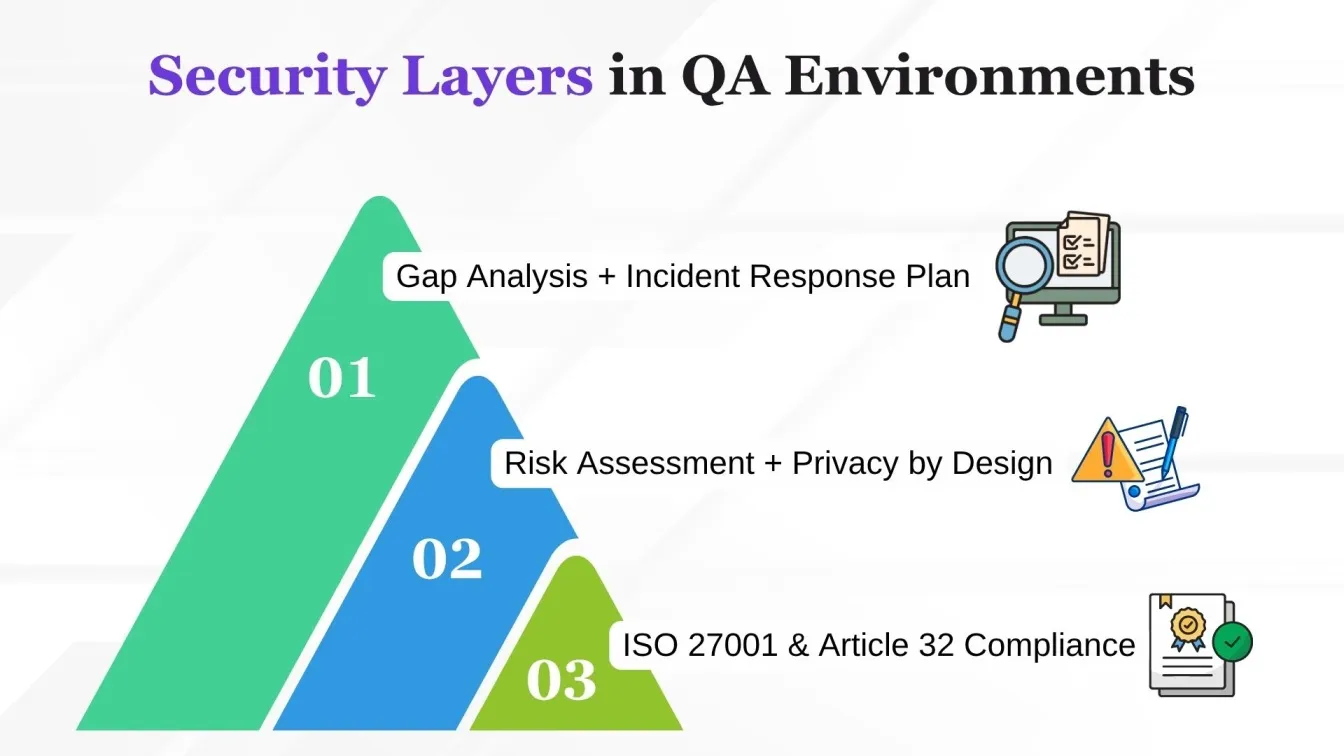
Collaborating with Third-party vendors demands a thorough Third-party assessment and enforcement of responsibilities among control owners. Adopting Privacy by Design principles and performing a detailed risk assessment supports information security across environments.
Involving Senior Management and conducting Gap Analysis helps maintain accountability and strengthens governance. Compliance with Article 32 and structured oversight from a Data Protection Officer further secures sensitive data during testing.
Testing for Data Access Controls in Applications
Testing data access controls is vital for maintaining GDPR compliance and ensuring secure, role-based access in modern applications. Software quality assurance teams must validate that only authorized users can view or process personal data under data privacy regulations and information security protocols.

- Perform access-level testing using automation test scripts and security testing tools to verify the enforcement of user rights.
- Conduct risk assessment and Gap Analysis to identify weak permission structures.
- Align with ISO 27001 and the Statement of Applicability for managing access control policies.
- Verify that Third-party vendors adhere to required security controls and perform a Third-party assessment.
- Ensure compliance with Article 32 and maintain visibility with a robust data flow map.
- Document responsibilities among control owners and escalate access risks to Senior Management.
Validating Data Deletion and Retention Policies
Validating data deletion and retention policies is essential for ensuring GDPR compliance and minimizing the risk of data breaches. Software testing tools and test automation services play a crucial role in ensuring that personal data is deleted or retained by the legal and regulatory timelines outlined in data protection laws.
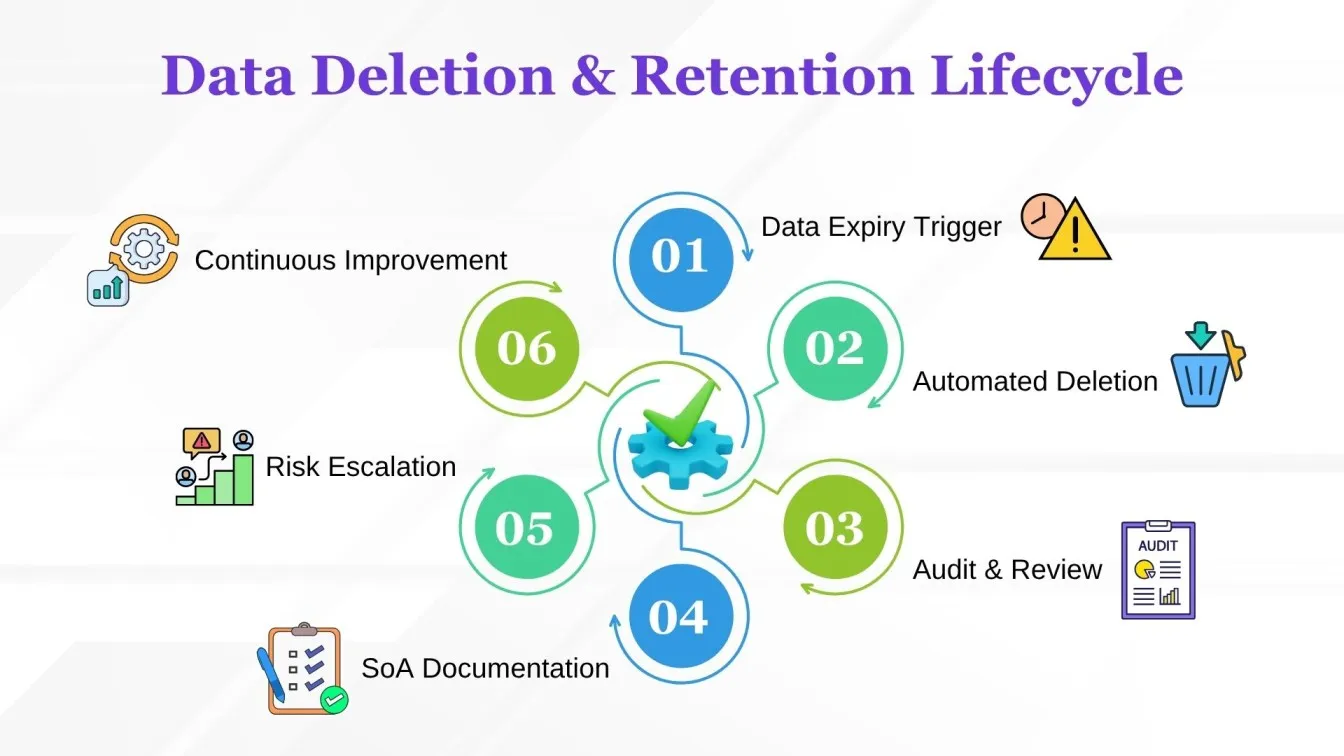
- Align with the Right to be Forgotten and privacy policy obligations under Article 32.
- Use automation test frameworks to simulate data expiry and deletion events.
- Conduct an internal audit and monitor with a Compliance Manager to ensure proper implementation.
- Document actions in the Statement of Applicability and maintain oversight from control owners.
- Validate data handling for Third-party vendors and cross-border data transfers in the European Economic Area.
- Report risks to Senior Management and ensure continuous improvement with a Maturity Model.
Ensuring Effective Consent Management Testing
A crucial component of GDPR compliance requirements is making sure consent management testing is done effectively. It enables organizations to uphold user trust and maintain transparency in how data and privacy are handled.
Through software quality assurance testing services, QA teams must verify that consent is actively collected, properly stored, and can be withdrawn at any time. Automation test scripts and security testing services help ensure these mechanisms function correctly.
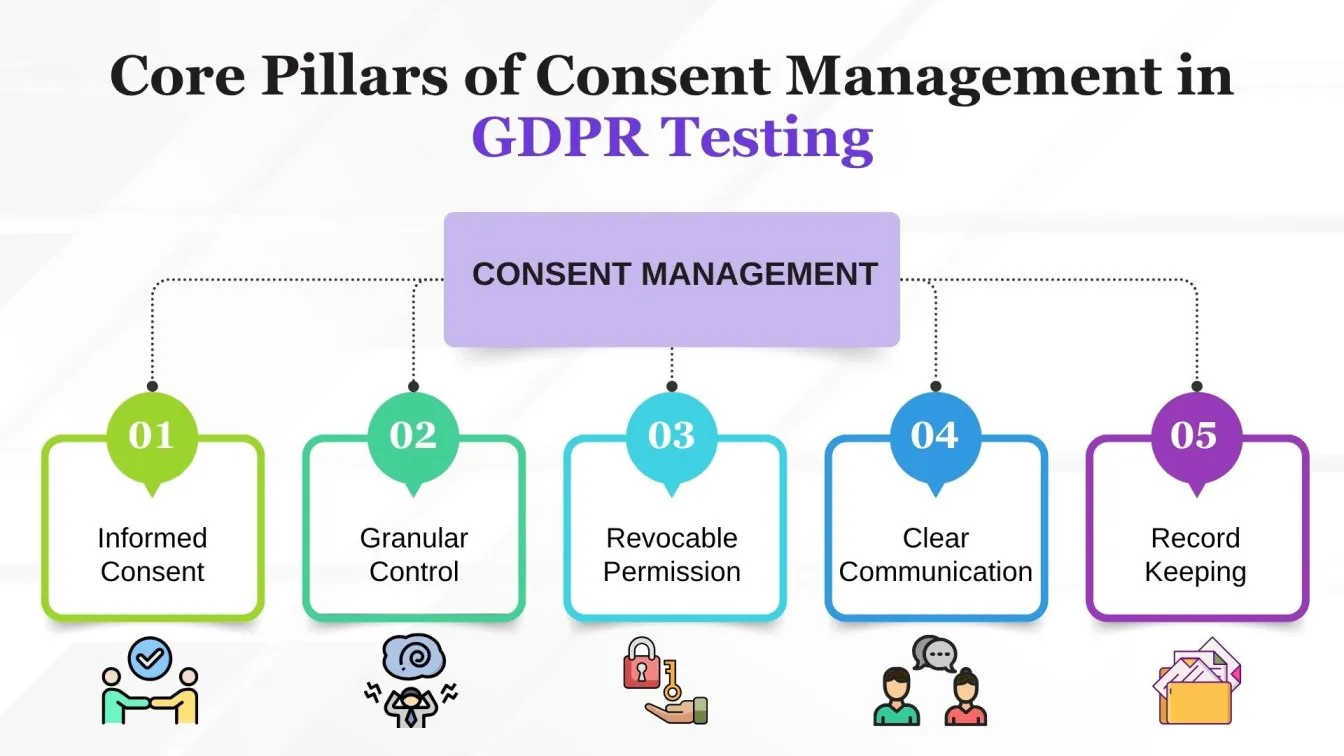
A clear and accessible privacy policy must explain user rights, including the Right to be forgotten. Auditing consent records with ISO 27001-aligned tools and maintaining updates in the Statement of Applicability supports ongoing compliance.
Integrations with third-party vendors must also be tested for consistent consent handling. Issues should be reported to Senior Management and tracked by the Compliance Manager. Applying information security standards and maintaining an incident response plan ensures unauthorized processing is prevented.
Testing Data Portability Features and Processes
Testing data portability features is essential for meeting GDPR compliance and respecting user data privacy rights. QA teams must validate that users can easily request, access, and transfer their data across platforms without risk.

Key Features to Test:
- Right to Data Portability: Ensure systems support export of structured, commonly used data formats.
- User Rights Management: Confirm user requests are handled securely and within GDPR-defined timeframes.
- Data Flow Map Accuracy: Validate all systems involved in the data exchange are properly mapped.
Processes to Test:
- Data Transfers: Verify secure handling during export and import across the European Economic Area.
- Third-Party Assessment: Test compliance and interoperability of integrated third-party vendors.
- Information Security Monitoring: Ensure continuous tracking using ISO 27001-aligned security controls.
Verifying Encryption and Anonymization Techniques
Verifying encryption and anonymization techniques is essential in software testing and security testing services to ensure full GDPR compliance. QA teams must enforce robust information security practices to protect personal data and prevent data breaches during test execution. Effective security controls and security measures should be validated at every layer of data handling.
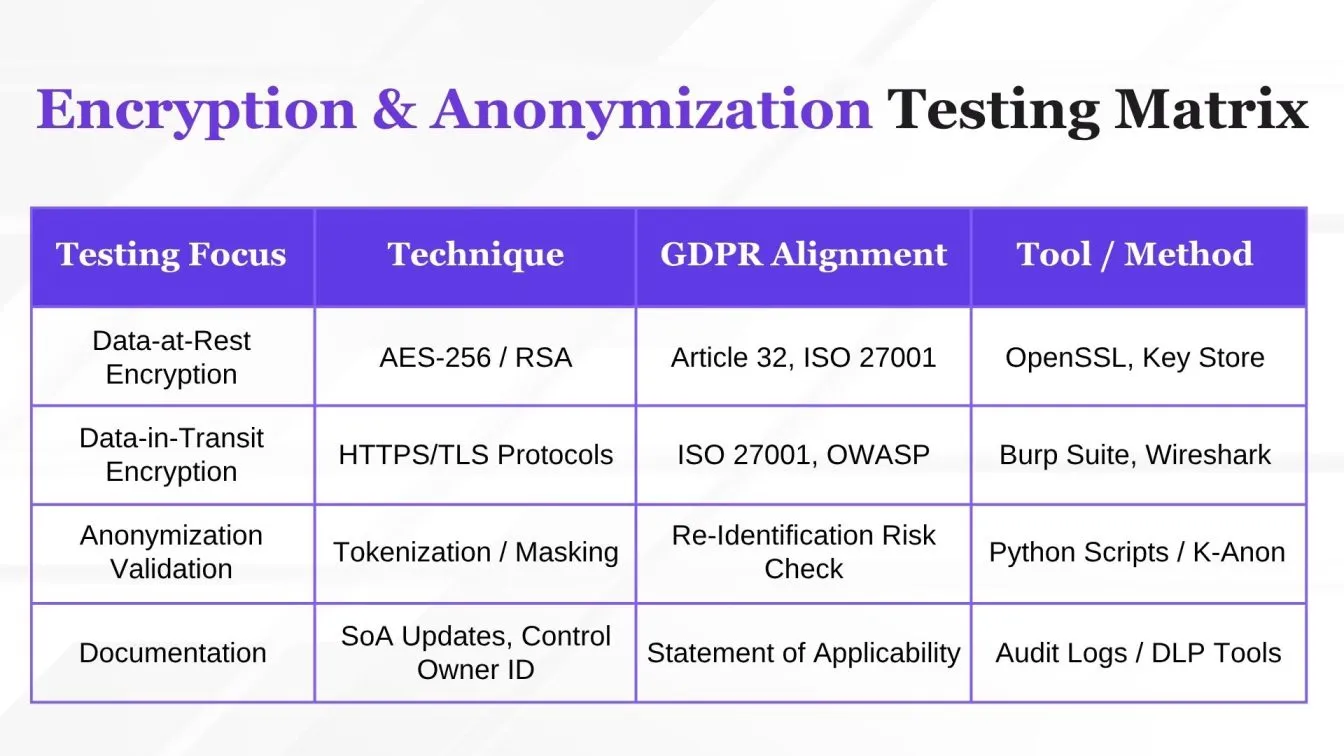
Testers can simulate encrypted data exchange and confirm anonymization logic in compliance with data privacy regulations by using test automation tools. Aligning with ISO 27001 requirements strengthens the technical safeguards. Involving control owners helps document responsibilities clearly in the Statement of Applicability, while testing against Article 32 requirements ensures legal alignment.
Anonymized datasets should be mapped in the data flow map and tested for re-identification risks using secure methods recommended by Senior Management and enforced by the Compliance Manager.
Logging and Monitoring GDPR Compliance Activities
Logging and monitoring GDPR compliance activities are vital for maintaining visibility and accountability throughout the software quality assurance process. QA teams should implement security controls and enforce strict information security protocols to track all access, changes, and data handling events.
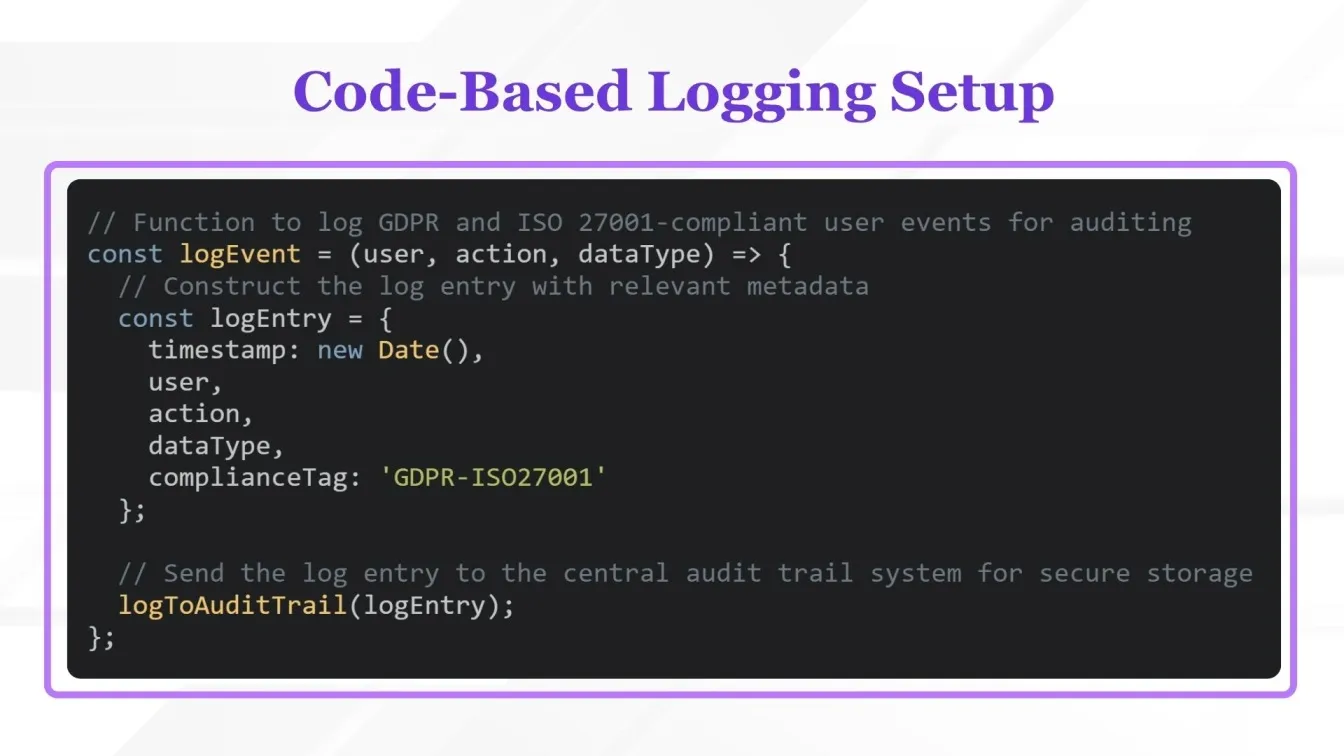
Effective logging supports the timely detection of data breaches and ensures alignment with ISO 27001 standards. Using advanced software testing tools and guidance from control owners, teams can document compliance actions within the Statement of Applicability.
Logs must cover data flow maps, Article 32 requirements, and interactions with third-party vendors. Involvement from Senior Management and updates by the Compliance Manager ensure that monitoring remains ongoing. These logs serve as evidence during audits and help strengthen organizational maturity under GDPR by protecting both intangible assets and user rights.
Top Tools for GDPR-Compliant Software Testing
Choosing the right software testing tools is crucial for achieving GDPR compliance and ensuring data privacy regulations are upheld throughout the software testing lifecycle. These tools help organizations meet ISO 27001 standards, reinforce security controls, and facilitate effective risk assessment and incident response plans.
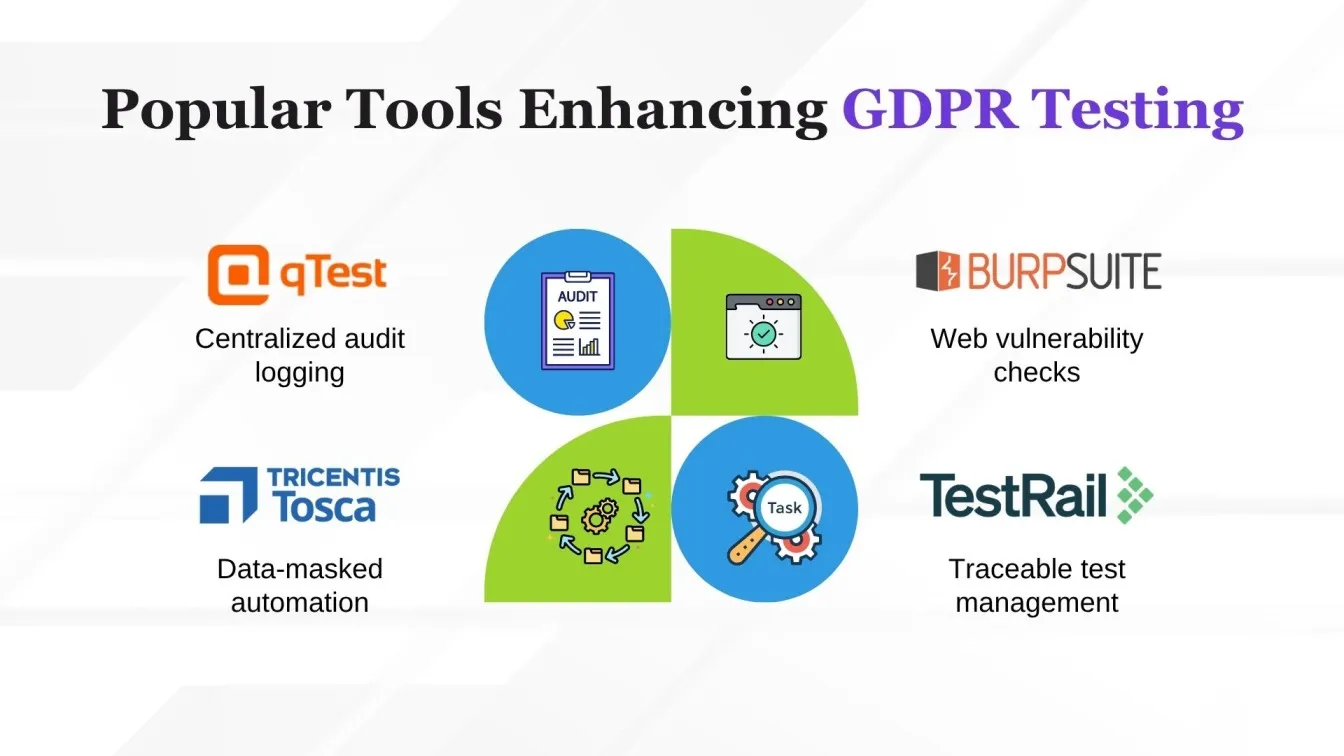
- Selenium Test Automation: Streamlines repetitive test tasks and confirms user rights along with consent flows, all while safeguarding intangible assets.
- Postman: A leading API testing tool that ensures secure validation of data flows while maintaining compliance with Article 32 and supporting secure data transfers.
- JMeter: Best suited for performance testing software, offering integrated security measures to simulate realistic loads while protecting data protection principles.
- Compliance Manager: Monitors and stores audit evidence, manages the Statement of Applicability, and promotes active involvement from Senior Management and control owners for GDPR audit readiness.
Common GDPR Compliance Mistakes QA Teams Should Avoid
QA teams play a vital role in ensuring GDPR compliance, but several avoidable mistakes can lead to data breaches and non-compliance with data protection law. Awareness and proactive mitigation are key to secure and compliant software testing services.
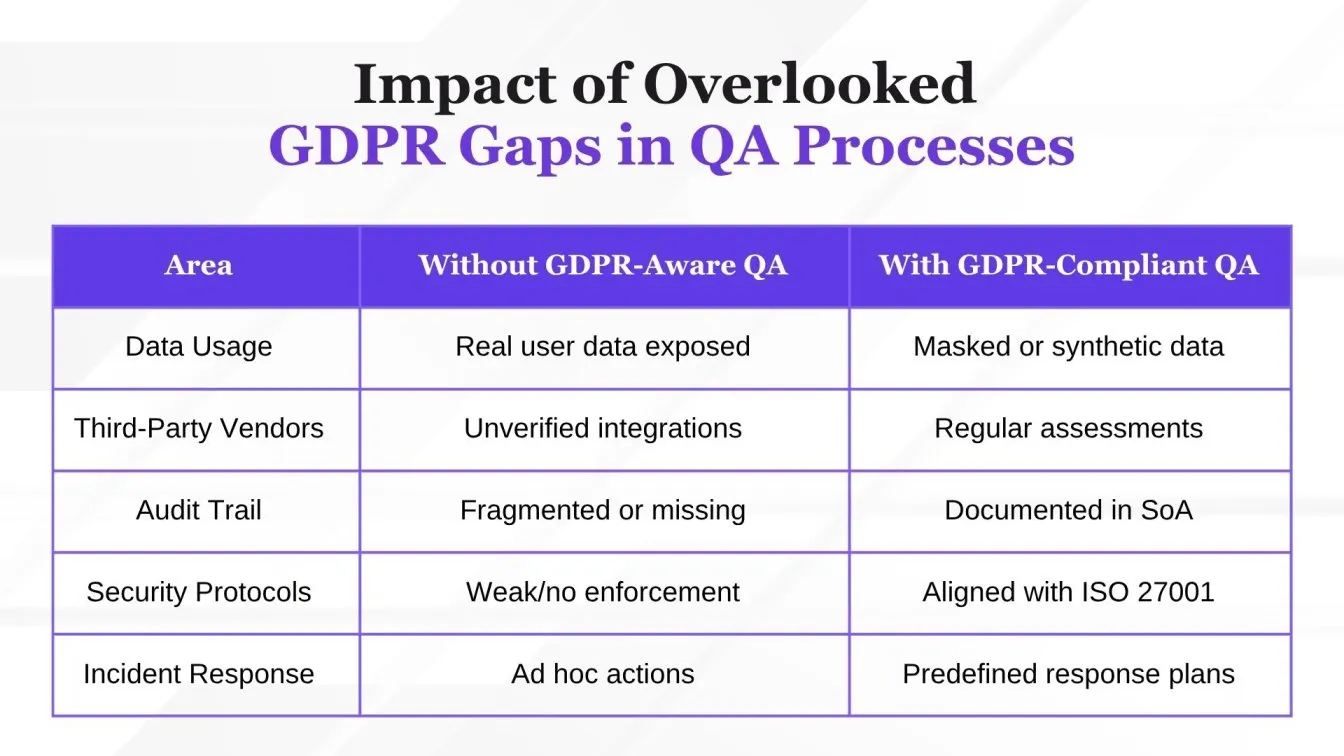
Common Mistake:
Using real user data without anonymization in test environments risks violations of information security and user rights.
Solution:
Adopt test automation tools with built-in masking, validate with security controls, and align practices with ISO 27001 and Article 32. Maintain documentation via the Statement of Applicability and involve control owners and Senior Management.
Common Mistake:
Failing to audit Third-party vendors for compliance.
Solution:
Conduct regular Third-party assessments, track gaps with the Compliance Manager, and maintain updated incident response plans to mitigate risk.
Conclusion: Make GDPR a Core Pillar of Your QA Strategy
Embedding GDPR compliance into your quality assurance testing process is essential to maintaining trust and legal readiness. Aligning software testing services with data privacy laws and security vulnerability testing strengthens protection against data breaches and misuse of physical assets.
Following structured guidelines from the EU General Data Protection Regulation, NIST SP 800-172, and the Digital Operational Resilience Act ensures comprehensive safeguards.
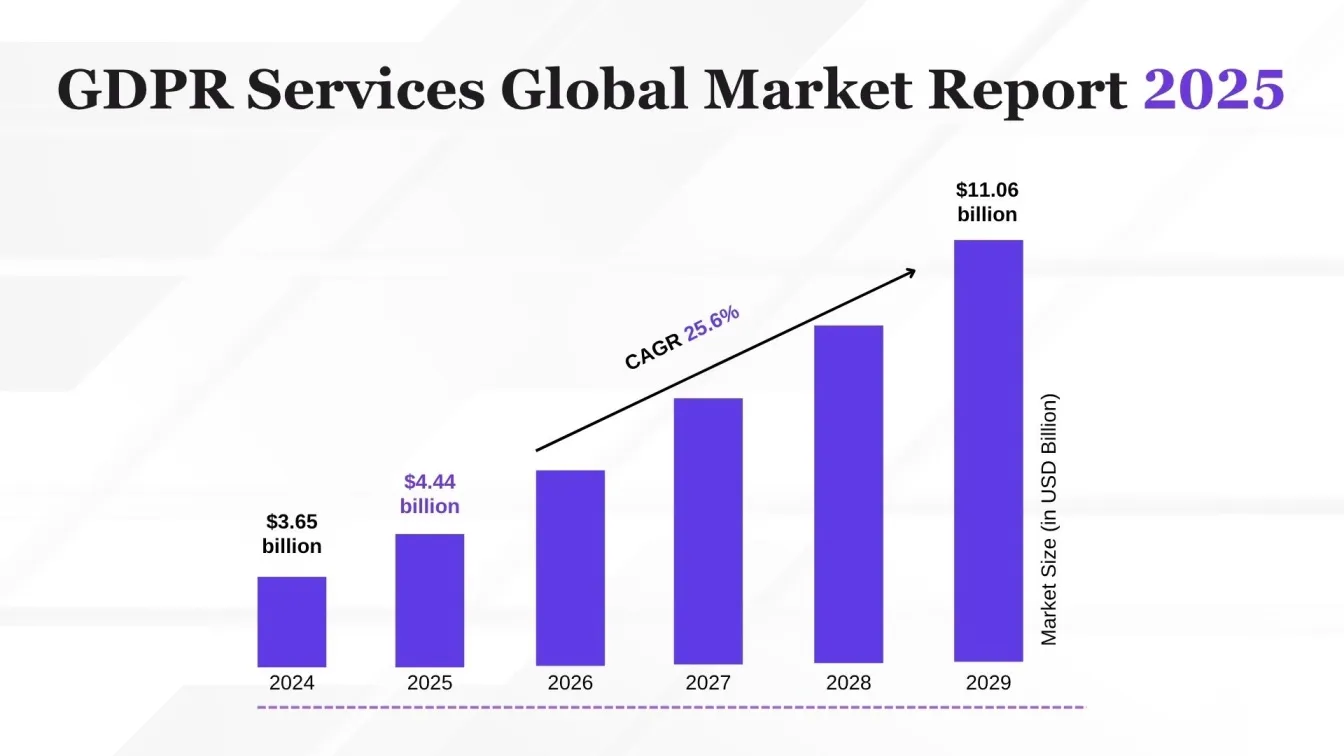
QA teams should use testing tools, maintain a clear data flow map, enforce privacy policy updates, and ensure that control owners and Senior Management are actively involved. Conducting regular internal audit activities and aligning with the Statement of Applicability reinforces ongoing compliance. Making GDPR a core part of your QA strategy creates a culture of security, accountability, and operational resilience across all testing processes.
Frugal Testing Hyderabad delivers top-tier QA testing services for enterprises, specializing in functional testing services and Selenium automation testing services.
For a detailed checklist, please reference this guide: GDPR Compliance Checklist – GDPR.eu
People Also Ask
1. What are the 7 data subject rights under GDPR?
The 7 data subject rights under GDPR include access, rectification, erasure, restriction, portability, objection, and rights related to automated decision-making, all designed to strengthen user data protection.
2. What are the 4 key characteristics of GDPR?
GDPR is defined by transparency, accountability, data minimization, and user consent, ensuring strong data privacy and compliance across all processing activities.
3. How do you balance functional testing and privacy requirements in QA?
Balancing functional testing with privacy requirements involves using anonymized datasets, enforcing strict data access controls, and aligning with GDPR compliance policies during QA processes.
4. How do test cases change under GDPR regulations?
Under GDPR, test cases must validate data minimization, encryption, consent flows, and ensure compliance with data subject rights and secure handling practices.
5. Can CI/CD pipelines create GDPR risks in testing environments?
Yes, insecure CI/CD pipelines can expose personal data; integrating secure testing tools and enforcing GDPR data protection controls is crucial for compliance.





%201.webp)

